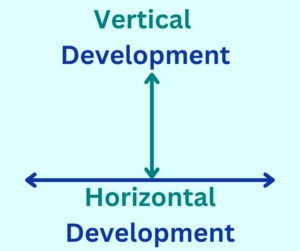
Our focus here is on a model of development stages or steps, defined by David Rooke and Bill Torbet in their popular 2005 article which was updated in 2020, “Seven Transformations of Leadership.” Each step both transcends and includes the prior steps: one typically goes through the steps in succession. The earlier knowledge and vantage point is incorporated into the next step and can now be used in a more strategic and productive way.
Leaders can be found operating at all seven steps, but in general become more effective — over longer periods, in more complex environments, and in conditions requiring organizational transformation — at the less common, later steps.
In the below table you see the seven steps with a brief description and the leadership prevalence identified in surveys. You’ll also notice a substantial progression up the developmental steps from 2005 to 2020. In the 2005 survey most leaders were in the Expert step, focused on logic and expertise, and the Achiever step, driven by personal and team achievement. By 2020, most leaders advanced to the Achiever step and the Redefining step – uniquely reframing complex dilemmas. The number of leaders in the Transforming step – generating personal and organizational transformation – more than doubled from 4% to 10%.
| Pre 2005 | 2012 – 2020 | |||
| Opportunist | Wins for self | 5% | 0% | |
| Diplomat | Wants to belong & fit in | 12% | 0.1% | |
| Expert | Focuses on logic and expertise | 38% | 4.3% | |
| Achiever | Driven by personal & team achievement | 30% | 33.7% | |
| Redefining | Uniquely reframes complex dilemmas | 10% | 52.1% | |
| Transforming | Generates personal and organizational transformation | 4% | 9.6% | |
| Alchemical | Integrates material & spiritual integration | 1% | 0.2% |
Some of this upward change was a result of the kind of people who made up the later sample (more coaches and consultants in 2020). At the same time, a significant cultural shift led an expanded recognition of multiple perspectives (national, class, racial, gendered), which encourages progression to the Redefining step to properly address the full complexity of leading in today’s world.

Transformational Leadership In Action
The article tells the story of Angela Merkel and her masterful use of the Redefining step. For brevity, here we focus on the example of Warren Buffet’s role in rescuing Salomon Brothers investment bank from bankruptcy in 1991, an example of the higher Transforming step. The table below maps out each step, introduces their corresponding type of power and inquiry, and shows key actions Buffet took along the way. Note how Buffet used multiple steps to produce a desired effect, integrating all of the lower steps into the higher step of transforming.
Buffett had a large investment stake in the company and sat on its board. A crisis brought on by illegal bidding and a subsequent cover-up within the company resulted in a front-page revelation by the New York Times, with a photo of the Chairman of the Board, John Gutfreund. Gutfreund called Buffett at 6:45am Omaha time (waking him up) to tell him the NY Federal Reserve Board was requiring Gutfreund’s immediate resignation. Salomon’s stock would not open for trading that (Friday) morning. By Sunday the crisis was over with Buffet at the helm.
Fallbacks Are A Positive Force
Fallbacks from the higher steps of development are a natural and necessary part of growth and happen more often at higher steps. When a leader interacts with people or a situation operating at a lower step, they can easily be pulled downward to this lower perspective. High stress or trauma can also bring about a fallback (think about your low moments during the pandemic!).
That’s why, as coaches or leaders, it is useful to know how prone we are to fallback so that we can recognize it and recover from it quickly, moving upward again to make better decisions and take the best steps. We are called to be mindful – to quickly wake up and become ‘conscious’ in the moment before we speak or act.

Theory Of Vertical Development
Since 2005, adult development theory in leadership has been increasingly referred to as “vertical” leadership development, in contrast with “horizontal” management training. The idea is that horizontal training can transmit new and critical skills and competencies to employees without challenging their current leadership development step.
The reference to ‘vertical’ conveys that each later step introduces us to a ‘higher consciousness’ that includes everything known to that point. One progresses to higher and higher ‘balconies’ — to an ‘eagle’s eye’ point of view — from which one appreciates and integrates the many forces operating on complex systems in determining what action is both right and timely.
According to developmental theory, ‘step transformation’ cannot be imposed from the outside, nor can it be activated solely from the inside by oneself because it’s difficult to see a higher vantage point without some prompting. The upward shift can be brought about by a “powerful conversational dance,” for example with a coach who is able to invite a client to see the situation from a new and higher perspective. A coach can also help a client rapidly notice a fallback in motion, and help the client get right back up to the higher step.
This rising and recovering is now called Vertical Leadership Development, a valuable process for advancing the development of leaders.
- At Talentum Mundi™ we apply the Vertical Leadership Development approach for ourselves first, to grow into the best coaches we can be.
- Then we explore the model with our clients, help them identify which leadership step they are mainly at, and how we can help them from a developmental perspective.
- Finally, we help our clients identify and recover from fallbacks, encouraging them to rise again.